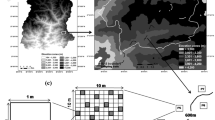Summary
Production during an assumed 131-day feeding season in 1974 was estimated for Orthoporus ornatus between 4.0 and 12.0 mm in midsegment width at Tornillo Flat, Big Bend National Park, Texas.
A conservative density estimate in 1973 of 1,302 millipedes ha-1 involved daily specimen removal from three, 929-m2 plots for a month. Each plot typified a different aspect of local desert vegetation; most specimens came from the plot with greatest plant diversity and relatively high (20%) cover.
Production calculations using 1973 density estimates were based on increase in size-class specific dry weight (minus gut contents) between 14 May and 21 September, 1974. Production ha-1 of cuticle and tissue was estimated at 0.85 kg (1972 kcal), while that of tissue alone came to 0.29 kg (1971 kcal).
Orthoporus ornatus from Albuquerque, New Mexico increased in dry weight during 92 days in 1974 more rapidly and to a greater extent than comparable size classes at Tornillo Flat.
An estimated feeding-season energy budget based on ash-free values of shrub food eaten at Tornillo Flat indicated ingestion ha-1 of 3,434 g (13,712 kcal) and defecation of 3,181 g (9,187 kcal). An independent estimate of ingestion based on known ingestion rates was 8,851 g ha-1.
Considering probable net primary production at Tornillo Flat, local O. ornatus exert a trophic impact similar to that of other large invertebrate detritivores elsewhere.
Similar content being viewed by others
References
Causey, N.B.: New North and Central American records of Orthoporus (Diplopoda: Spirostreptida). Proc. biol. Soc. Wash. 77, 175–182 (1964)
Causey, N.B.: Desert millipedes (Spirostreptidae, Spirostreptida) of the southwestern United States and adjacent Mexico. Occasional Papers, The Museum, Texas Tech. University 35, 1–12 (1975)
Chew, R.M., Chew, A.E.: Energy relationships of the mammals of a desert shrub (Larrea tridentata) community. Ecol. Monogr. 46, 1021 (1970)
Crawford, C.S.: Water relations in a desert millipede (Orthoporus ornatus, Girard) (Spirostreptidae). Comp. Biochem. Physiol. 42A, 521–535 (1972)
Edwards, C.A., Reichle, D.E., Crossley, D.A., Jr.: The role of soil invertebrates in turnover of organic matter and nutrients. In: Analysis of temperature forest ecosystems (D.E. Reichle, ed.), pp. 147–172. Berlin-Heidelberg-New York: Springer 1970
Haverty, M.I., Nutting, W.L.: Density, dispersion, and composition of desert termite foraging populations and their relationship to superficial dead wood. Environ. Entomol. 4, 480–486 (1975)
Johnson, K.A., Whitford, W.G.: Foraging ecology and relative importance of subterranean termites in Chihuahuan desert ecosystems. Environ. Entomol. 4, 66–70 (1975)
Kaczmarck, W.: Elements of organization in the energy flow of forest ecosystems (preliminary notes). In: Secondary productivity of terrestrial ecosystems (principles and methods) (K. Petrusewicz, ed.), pp. 663–678. Warzawa-Krakow: 1967
Kitazawa, Y.: Community metabolism of soil, invertebrates in forest ecosystems of Japan, In: Secondary productivity of terrestrial ecosystems (principles and methods) (K. Petrusewicz, ed.), pp. 649–660. Warzawa-Krakow: 1967
Lowe, C.H.: Appraisal of research on fauna in desert environments. In: Deserts of the world, an appraisal of research into their physical and biological environments (W.G. McGinnis, B.J. Goldman, P. Paylore, eds.), pp. 569–645. Tuscon: Univ. of Arizona Press 1968
McBrayer, J.F.: Exploitation of deciduous leaf litter by Apheloria montana (Diplopoda. Eurydesmidae). Pedobiologia 13, 90–98 (1973)
Petrusewicz, K., Macfadyen, A.: Productivity of terrestrial animals, principles and methods. IBP Handbook, No. 13. Philadelphia: Davis 1970
Reichle, D.E.: Energy and nutrient metabolism in soil and litter invertebrates, In: Productivity of forest ecosystems (P. Duvigneaud, ed.), pp. 465–477. Paris: Unesco 1971
Saito, S.: Productivity of high and low density populations of Japonaria, laminata armigera (Diplopoda) in a warm-temperate forest ecosystem. Res. Pop. Ecol. (Kyoto). 9, 153–166 (1967)
Saito, S.: Energetics of isopod populations in a forest of central Japan. Res. Pop. Ecol. (Kyoto) 11, 229–258 (1969)
Soholt, L.F.: Consumption of primary productivity by a population of Kangaroo rats (Dipdomys merriami) in the Mojave desert. Ecol. Monogr. 43, 357–376 (1973)
Verhoeff, J.M., Von: Zur Biologie der Spirostreptiden. Zool. Anz. 109, 288–292 (1935)
Wooten, R.C., Jr., Crawford, C.S.: Respiratory metabolism of the desert millipede Orthoporus ornatus (Girard) (Diplopoda). Oecologia (Berl.) 17, 179–186 (1974)
Wooten, R.C., Jr., Crawford, C.S.: Food, ingestion rates, and assimilation in the desert millipede Orthoporus ornatus (Girard) (Diplopoda). Oecologia (Berl.) 20 231–236 (1975)
Wooten, R.C., Jr., Crawford, C.S., Riddle, W.A.: Behavioural thermoregulation of Orthoporus ornatus (Diplopoda: Spirostreptidae) in three desert habitats. Zool. J. Linn. Soc. 57, 59–74 (1975)
Author information
Authors and Affiliations
Rights and permissions
About this article
Cite this article
Crawford, C.S. Feeding-season production in the desert millipede Orthoporus ornatus (Girard) (Diplopoda). Oecologia 24, 265–276 (1976). https://doi.org/10.1007/BF00345478
Received:
Issue Date:
DOI: https://doi.org/10.1007/BF00345478




